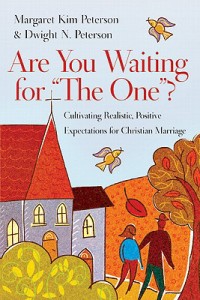A friend of mine and fellow blogger – the lovely SVB – recently wrote a thought provoking post about dating on one of her blogs.
In it, she mentioned a magazine article she had read, written for women, but by a man. Here’s a snippet from SVB’s post:
[The magazine article’s writer says women] shouldn’t be quick to give themselves physically, emotionally, mentally, and spiritually to every man who shows them attention. Rather, they should be more concerned with falling in love with God and letting that be enough and then patiently waiting for God to bring them a man–someone who will value their faith and virtue, and encourage them in it. It’s a beautiful sentiment. It’s hopeful, optimistic.
I can’t believe it.
I say those words not in a, “Oh wow, this is so beautiful, I can’t believe God loves me this much, this is amazing!” type of way. I mean I literally cannot believe what this man is saying. I want to believe it. I agree that what the author lays out is how things should be, but it’s not how things actually are.
Indeed it isn’t. So how are things actually?
Complicated.
There is no short answer, no explanation that isn’t complex, no reality completely pleasant. Relationships are messy and people are a mess. If I could sum up the struggle SVB wrote about in her post, I’d put it like this:
As Christians, we are told to, called to, want to save sex for marriage, to seek first the kingdom, to discern before we date, all in a culture that doesn’t.
We are told, called to, want to do X, in other words, while we are…
- surrounded by Y
- in a culture that sets us up for Y
- where Y is normal, and where X, therefore, is not.
It’s like growing up with unfettered access to unlimited texts, instant messaging, instant movies, fast food, an iPad, an iPod and iTunes (which is now the norm – a norm which, by default, renders patience and moderation obsolete) but being expected to become an adult who can be patient and participate in anything only moderately.
So, basically, our culture is an environment that is not conducive to patience. Kids rarely (if ever) have to wait, and if we ever tell them to wait, we subsequently discover that they literally can’t. Which makes sense, because you can’t provide a kid with a life that requires no patience and have it result in an adult who can be patient. You can’t provide a kid with a life of excess and have it result in an adult who embraces moderation. And I think deep down, people know this, which is why our culture’s response to it is disheartening: We see that kids are impatient, so we accept kids as impatient. Kids see that adults expect them to be impatient, so they don’t think they have to be patient. And rather than teach them that they have to be patient and show them how to be patient, we just lower the bar (which results in a bunch of impatient adults).
In the same way, most people who want to do X in a culture only conducive to Y will wind up going for Y.
It’s like this:
We see that people don’t save sex for marriage.
We see that many men and women lack integrity, or are selfish, immature or dishonest.
We can continue not to date them, or we can lower the bar.
Most people lower the bar.
But most people don’t understand the damage that it does.
When we lower that bar, “a man or woman who a) lacks integrity, or who b) is selfish, immature or dishonest, or who c) will not wait until marriage to have sex with us (or some combination of the three)” ceases to describe men and women who aren’t good for us. It just becomes a description of men and women, period. So regardless of whether the men and women who exhibit those traits are the norm, we decide that they are.
And once the men and women who exhibit those traits are simply “men and women” to us, we either don’t date, or we date anyway. And if we do date, because the men and women who exhibit those traits are the norm, they are also the expectation. And when we expect that, we can accept that. So we settle for men and women who fit that description. But we don’t even realize we’re settling, because, as far as we’re concerned (once we’ve lowered the bar), we are just getting guys and girls who are normal – guys and girls who are good as guys and girls can get. But as long as we assume that that is as good as guys and girls can get, we will feel content to have wound up with a guy or a girl like that. And as long as we are content to wind up with that kind of person, people will be content being that kind of person.
Which is how that kind of person becomes the norm.
Which is why people like SVB and me are single a lot.
Back to the question. Do you know what that’s like?
Regardless of who you are and how you live, even if you don’t believe in soul mates or “the one” (and sorry kids, but neither exists!), meeting somebody with whom you are truly compatible is like finding a needle in a haystack. But when you’re saving sex for marriage, seeking first the kingdom and discerning before you date, you can’t even find the haystack.
SVB puts it this way:
…sometimes I wonder if we, the Christian girls, have got it all wrong. What if this so-called man the author outlines, the one that is supposed to fall in love with us and our virtue and faith, doesn’t exist?
If we lower the bar, he doesn’t have to exist.
If we lower the bar…
He sees that we don’t expect him to aim higher.
So he doesn’t.
We give him permission to sell himself short.
So he does.
We act like a man can’t date without having sex.
So guys don’t have to date without having sex.
Really, we sell them short.
I think the fear here is that so many bars are so low now that no guy will want to reach as high as ours.
And that is a risk I am frankly willing to take.
– – – – –
Click here to read SVB’s post in full.
Click here to check out SVB’s other blog, “That’s What She Said.”


